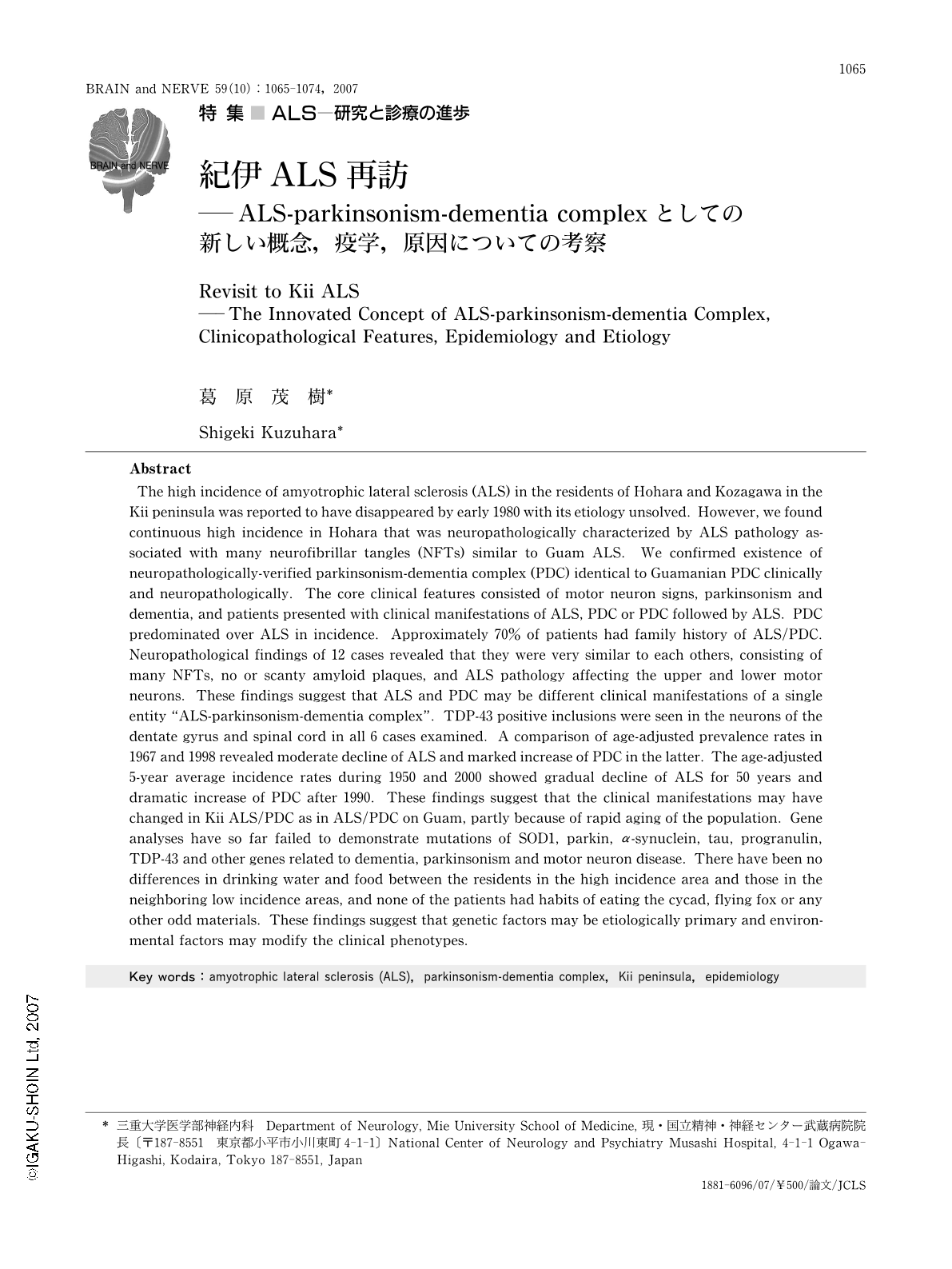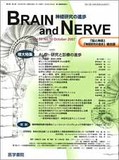Japanese
English
- 有料閲覧
- Abstract 文献概要
- 1ページ目 Look Inside
- 参考文献 Reference
はじめに
紀伊半島の熊野なだに沿った山岳地帯は牟婁(むろ)地方と呼ばれ,グアム島と並ぶ筋萎縮性側索硬化症(amyotrophic lateral sclerosis:ALS)の集積地が点在する。この地域のALSに関する最初の記載は,今から約320年前の元禄2年に刊行された本朝故事因縁集1)に出てくる「古座の足萎え」が最初とされる。明治以降の医学雑誌には,既にこの地方にALSが多発することについて記載があるが,これを疫学調査によって実証したのは,和歌山県立医科大学の木村 潔,八瀬善郎らであった2)。しかし,多発の原因は明らかにされないままALS発生は激減し始め,1980年代初頭までにグアム3)と紀伊4)の高集積地が消滅したことが報告された。しかし,筆者らは1994年以降に疫学調査を実施し,集積地ではALSの高頻度発生が続いていることを報告し5),グアム特有の疾患であるパーキンソン認知症複合(parkinsonism-dementia complex: PDC)が紀伊半島ALS集積地にも存在することを,神経病理学的検索例で初めて示した6)。
本稿では,紀伊ALSを臨床病理学的に再評価した結果,臨床表現型は3つの主要徴候の組み合わせとして出現するが,神経病理学的にはほぼ均一な所見を呈する“ALS-parkinsonism-dementia complex”という疾患概念として把握できるという根拠を述べ,病型の疫学的変遷と病因については,グアム研究と対比させながら概観してみたい。
Abstract
The high incidence of amyotrophic lateral sclerosis (ALS) in the residents of Hohara and Kozagawa in the Kii peninsula was reported to have disappeared by early 1980 with its etiology unsolved. However, we found continuous high incidence in Hohara that was neuropathologically characterized by ALS pathology associated with many neurofibrillar tangles (NFTs) similar to Guam ALS. We confirmed existence of neuropathologically-verified parkinsonism-dementia complex (PDC) identical to Guamanian PDC clinically and neuropathologically. The core clinical features consisted of motor neuron signs, parkinsonism and dementia, and patients presented with clinical manifestations of ALS, PDC or PDC followed by ALS. PDC predominated over ALS in incidence. Approximately 70% of patients had family history of ALS/PDC. Neuropathological findings of 12 cases revealed that they were very similar to each others, consisting of many NFTs, no or scanty amyloid plaques, and ALS pathology affecting the upper and lower motor neurons. These findings suggest that ALS and PDC may be different clinical manifestations of a single entity "ALS-parkinsonism-dementia complex". TDP-43 positive inclusions were seen in the neurons of the dentate gyrus and spinal cord in all 6 cases examined. A comparison of age-adjusted prevalence rates in 1967 and 1998 revealed moderate decline of ALS and marked increase of PDC in the latter. The age-adjusted 5-year average incidence rates during 1950 and 2000 showed gradual decline of ALS for 50 years and dramatic increase of PDC after 1990. These findings suggest that the clinical manifestations may have changed in Kii ALS/PDC as in ALS/PDC on Guam, partly because of rapid aging of the population. Gene analyses have so far failed to demonstrate mutations of SOD1, parkin, α-synuclein, tau, progranulin, TDP-43 and other genes related to dementia, parkinsonism and motor neuron disease. There have been no differences in drinking water and food between the residents in the high incidence area and those in the neighboring low incidence areas, and none of the patients had habits of eating the cycad, flying fox or any other odd materials. These findings suggest that genetic factors may be etiologically primary and environmental factors may modify the clinical phenotypes.

Copyright © 2007, Igaku-Shoin Ltd. All rights reserved.


